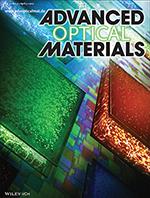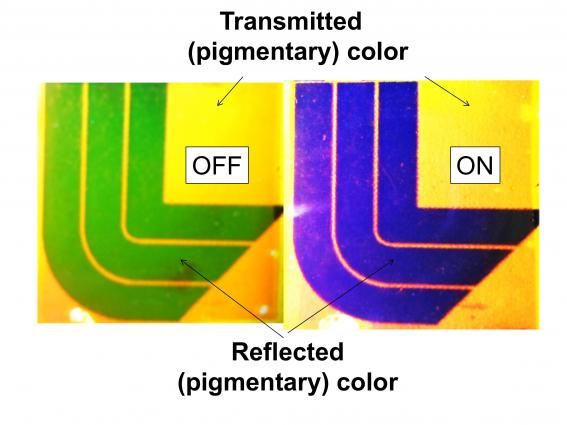Research comes through with flying colors
 (Download Image)
Dynamic color tunability of amorphous photonic structures in response to external electrical stimuli using electrophoretic deposition process. Image by Ryan Chen/LLNL
(Download Image)
Dynamic color tunability of amorphous photonic structures in response to external electrical stimuli using electrophoretic deposition process. Image by Ryan Chen/LLNL
Like a chameleon changing colors to blend into the environment, Lawrence Livermore researchers have created a technique to change the color of assembled nanoparticles with an electrical stimulant.
The team used core/shell nanoparticles to improve color contrast and expand color schemes by using a combination of pigmentary color (from inherent properties) and structural color (from particle assemblies).
"We were motivated by various examples in living organisms, such as birds, insects and plants," said Jinkyu Han, lead author of a paper appearing on the cover of the April 3 edition of the journal Advanced Optics Materials. "The assemblies of core/shell nanoparticles can not only imitate interesting colors observed in living organisms, but can be applied in electronic paper displays and colored-reflective photonic displays."
Applications of electronic visual displays include electronic pricing labels in retail shops and digital signage, time tables at bus stations, electronic billboards, mobile phone displays and e-readers able to display digital versions of books and magazines.
The resulting non-iridescent brilliant colors can be manipulated by shell thickness, particle concentration and external electrical stimuli using an electrophoretic deposition process.
The technique is fully reversible with instantaneous color changes as well as noticeable differences between transmitted and reflected colors.
The particle arrangement in the system is not perfectly ordered nor crystalline, referred to as "amorphous photonic crystal," which creates the resulting color from light reflection that does not change with viewing angles.
"The angle independence of the observed colors from the assemblies is quite a unique and interesting property of our system and is ideal for display applications," Han said.
The resulting color is dynamically tunable in response to electric stimuli since the nanoparticle arrangement (i.e., inter-particle distance, particle structures) is highly affected by the electric field.
Contributing authors are Elaine Lee, Jessica Dudoff, Michael Bagge-Hansen, Jonathan Lee, Andrew Pascall, Joshua Kuntz, Trevor Willey, Marcus Worsley and T. Yong-Jin Han.
Contact
 Anne M. Stark
Anne M. Stark
[email protected]
(925) 422-9799
Related Links
Advanced Optics MaterialFunctional Materials Synthesis and Integration
Tags
Physical and Life SciencesFeatured Articles









